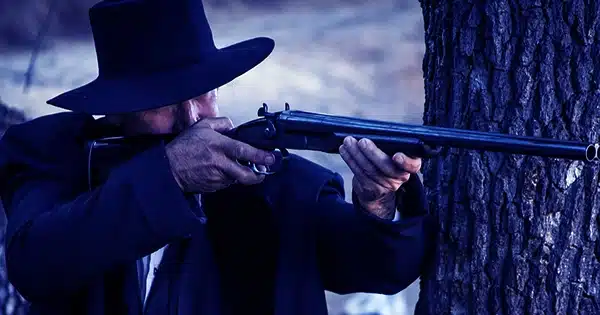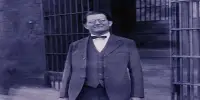Edward “Ned” Kelly became a well-known Australian bushranger, criminal, gang president, and condemned cop killer. In his final encounter with the authorities, he wore a bulletproof suit of armor built from plow mouldboards. Some perceive him as Australia’s Robin Hood, while others see him as nothing more than a murderer. In any case, he’s become something of a folk hero.
Rebellion seeds
Ned Kelly’s childhood was blighted by adversity and poverty. John “Red” Kelly, his father, was an Irish convict who was deported to Australia after being found guilty of stealing two pigs. The senior Kelly and his wife battled to make ends meet, and he was constantly in and out of trouble while he raised his family. Ned, too, struggled with similar issues from a young age.
The Kelly family moved around in quest of a better life, but hardship always seemed to follow them. Ned encountered Harry Power, a convict who had turned to bushranging after escaping from a Melbourne prison. Soon after, the 14-year-old got into a fight with a pig-and-fowl dealer, which resulted in his first run-in with the cops. The charges against him were later dropped.

After serving a three-month term for a different offense, Ned’s life took a disastrous turn when he was wrongly accused of horse theft. Kelly and another guy, Alex Gunn, were given sentences to three years in jail, with remission granted for good behavior. The encounter instilled in the young kid the seeds of resistance. He developed resentment for the police, whom he saw as crooked and unjust, setting the framework for his future as an outlaw.
Stringybark Creek police officers were murdered
As he grew older, Ned Kelly became more involved in illegal operations, frequently with his brother, Dan, and their acquaintances. They were especially concerned with horse theft, which frequently ended in violent shootouts.
The Kelly Gang fought with a party of police officers commanded by Sergeant Michael Kennedy in October 1878 near Stringybark Creek in Victoria. Ned and the others killed three officers, including Kennedy, during the violent encounter. In retaliation, the Victorian government established rewards for the apprehension of the Kelly Gang.
The Stringybark Creek police murders were a watershed point in the young man’s life, catapulting him into the ranks of the colony’s most sought outlaws. The police’s pursuit became more intense, and the Kelly Gang’s renown grew with each daring heist and encounter.
Kelly Gang’s reign of outlawry
Following the police deaths at Stringybark Creek, the Kelly Gang vowed an open attack on the colonial authority. Robberies provided much-needed revenue while also enhancing the gang’s reputation as bushrangers.
The raids at Euroa in December 1878 and Jerilderie in February of the following year were among the most notorious. Following the Jerilderie raid, the New South Wales government teamed up with local banks to offer a £4,000 reward for the apprehension of the Kelly Gang, dead or alive, which the Victorian government matched, increasing the total prize to £8,000. This was the largest-ever reward for the capture of bushrangers at the time.
Ned Kelly’s famous suit of armor
The Kelly Gang’s daring armor-clad clash at the Glenrowan Inn in 1880 cemented Ned Kelly’s place in Australian history.
Ned, his brother, and their two companions, Steve Hart and Joe Byrne, wore homemade armor they’d painstakingly built from plow parts. These legendary outfits were designed to protect them from police gunfire and took four to five months to create. Ned’s armor weighed 97 pounds and protected important body parts such as the head, chest, and thighs. He was the only one with a rear plate.
The gang assumed that these sets of armor would protect them, and they were correct. Having said that, each bullet caused considerable bruises, wounds, and, in the case of head impacts, concussions.
Glenrowan Affair
The Glenrowan Affair was set in motion when the Kelly Gang hatched a scheme to derail a police train and ambush cops as they arrived to investigate. The scheme, however, was jeopardized by an informant who forewarned the police.
On that fateful night in June 1880, the authorities surrounded the Glenrowan Inn, resulting in a dramatic standoff. The Kelly Gang had taken possession of the inn and its inmates the day before, preparing for the impending battle.
The siege began with the gang firing rounds at the police, who responded by raining bullets on the Glenrowan Inn. Dan Kelly, Steve Hart, and Joe Byrne were all killed, leaving Ned Kelly as the only survivor of the gang. Several captives were also killed during the firefight.
Even after receiving many gunshot wounds, Ned fought on in his suit of armor.
Ned Kelly’s capture and execution
Despite his stubborn struggle, Ned Kelly’s last stand was cut short when he was seriously injured and apprehended by authorities. His injuries, along with the weight of his armor, had made moving difficult, let alone aiming his handguns.
He was charged with the killings of constables Thomas Lonigan and Michael Scanlan, who were killed during the Stringybark Creek incident, after being taken to Melbourne. Only the counts pertaining to Lonigan’s death were tried. Ned’s guilt was a source of contention. Some considered him a dangerous criminal, while others saw him as an oppressed rebel.
Despite this, he was convicted and sentenced to death by hanging.
A solemn audience saw Ned’s death at the Old Melbourne Gaol on November 11, 1880. Some media said that his final words were “Such is life,” while others said, “Ah, well, I suppose it has come to this.”
Ned Kelly’s legacy
The legend of Ned Kelly grew in the aftermath of his death. His achievements were idealized in ballads, poetry, and stories, and his armor became an enduring symbol of resistance and defiance. People from all walks of life chimed in on the discussion, with some celebrating him as a folk hero and others condemning him as a cold-blooded murderer.
Ned Kelly’s life, defined by rebellion, criminality, and a spectacular final stand, continues to captivate Australians and the rest of the world. Whether he is viewed as a criminal or a folk hero, his story is compelling.















